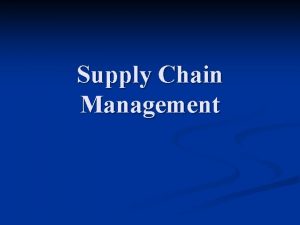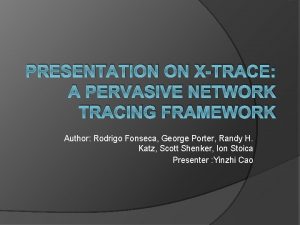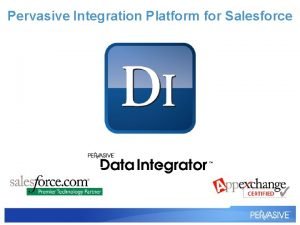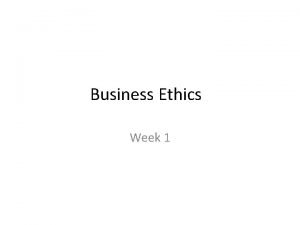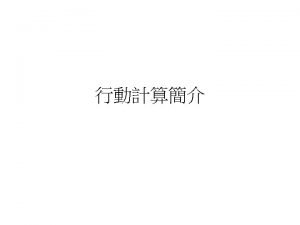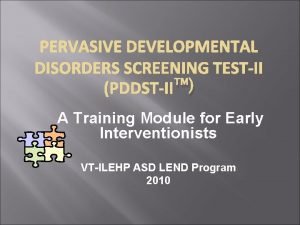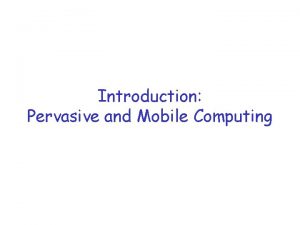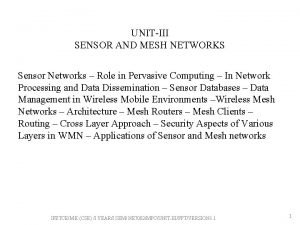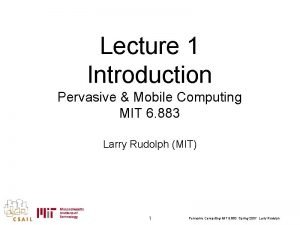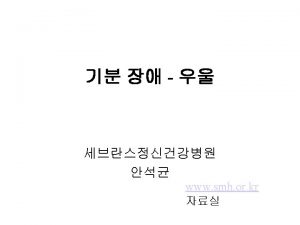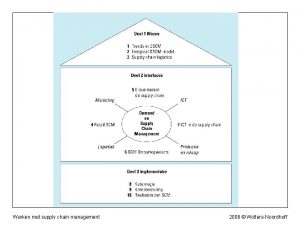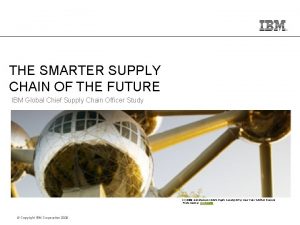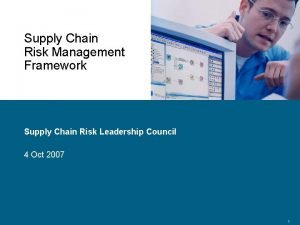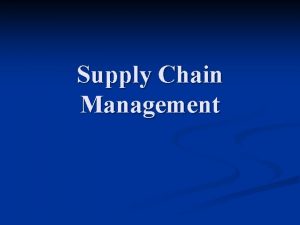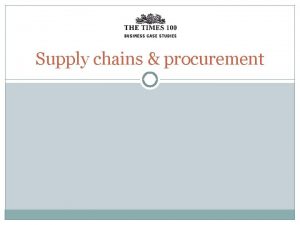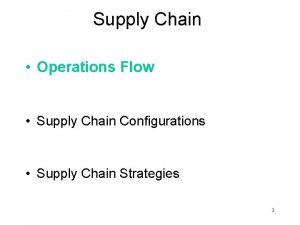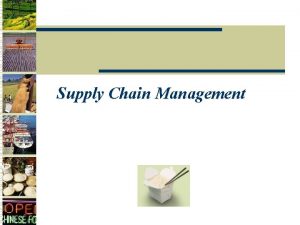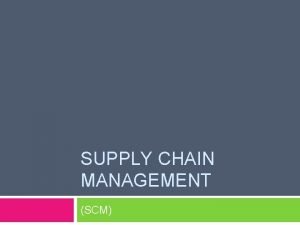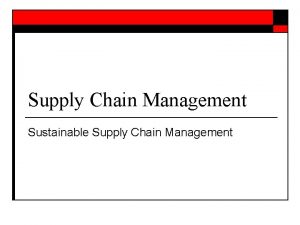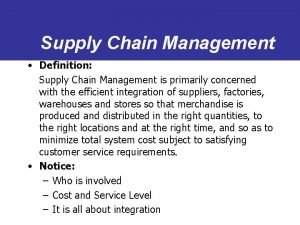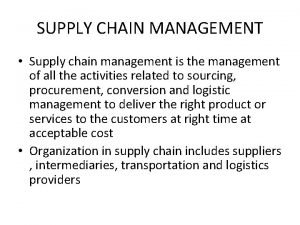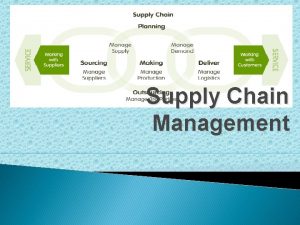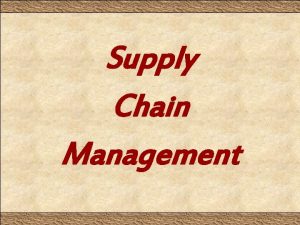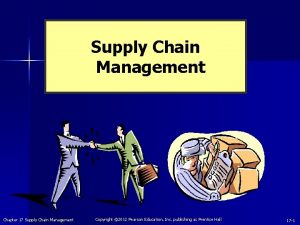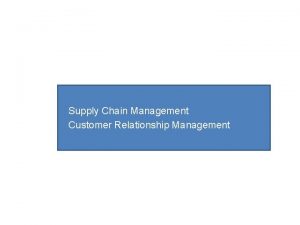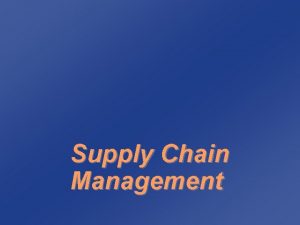Supply Chain Management Technology Applications Technology A pervasive




















- Slides: 20

Supply Chain Management Technology & Applications Technology: A pervasive factor in Logistics Fulfillment

Technology: A pervasive factor in Logistics Fulfillment u Technology is a mean to enhance business competitiveness and performance. u Technology has become the key factor in defining the competitive advantage in today’s business world. u Information Technology helps in real time information processing while, u Robotics & Automation technologies helps in performing the repetitive operations with greater speed and accuracy. u On communications front, ease and speed of transactions have changed drastically. u As a result, the accuracy, reliability & speed in material and information flow in supply chain has enhanced manifolds leading to productivity, effectiveness & efficiency in logistics operations today.

Technology: A pervasive factor in Logistics Fulfillment u The latest technologies being used in logistics are in the areas of: u Automatic identification, u Communication, u Material handling, u Facility Design.

Automatic Identification Technology u Automatic Identification (Auto-ID) is the term used to describe the direct entry of data or information in the computer system, Programmable logic controllers or any microprocessor-controlled device. u Auto ID includes – – – Barcodes RFID Data Communication Magnetic strip Voice recognition u Advantages – A carton moving on the conveyor at a speed of 100 feet per min. – Truck carrying goods on time-bound dispatches to the customers. – Etc.

Automatic Identification Technology u Benefits: – Accuracy: Error free data entry without human involvement. – Cost Saving: Reliable and correct information » Speed: Voluminous data can be stored, retrieved and transferred within a faction of a second. » Convenience: These technologies are user friendly and provide ease in connectivity to a wider range of processing and controlling equipment.

Automatic Identification Technology u Barcodes: – Most popular technology & are used for identification, handling, retrieval and storage of goods in warehouse & stores. – Its further used for the communication of items for preparing the bills of quantity and reports on inventory turnover & sales. – It is used for tracking a particular inventory item during packaging, material pickup, transportation or inventory audit. – Information that may be required, generally is about the country code, manufacturer’s name, product details, date of manufacture, material content, and so on.

Automatic Identification Technology u Barcodes: – It is the sequence of parallel lines with different thickness with spaces in between. – These bars are nothing but items of information in codified form which can be decodified or read with the help of a scanner. – In other words, bar code is a form of Morse code to put information of an item in code language. – Initiated in 1952 at supermarkets in USA – In 1960, it was used on trial basis. UPC system introduced. – In 1974, it gained widespread acceptance.

Automatic Identification Technology u Barcodes: – Bar codes are represented by SYMBOLOGIES used. – There are 260 symbologies available for different application for different product recognition for different industries. – Most industries have formulated their own symbologies based on the following factors. » Ease in usage of a symbology in a particular industry » Nature and type of data to be encoded. u(Binary, letter, number, ASCII) » Information fields to be encoded » Feasibility of universal acceptance. » Location and size of code on product item.

Automatic Identification Technology u Barcodes: – Bar code symbologies have been divided into three broad categories – Linear: » Linear Symbologies consists of single row of bars & can be read by a single line scanner. – Stacked: » Consists of several rows of bars and spaces, and can be read by a multiple ID scanner. – Matrix: » Polygonal array of data cells and are read from a 2 D image scanner.

Automatic Identification Technology u Barcodes: -

Automatic Identification Technology u Barcodes: -

Automatic Identification Technology u Barcodes: -

Automatic Identification Technology u Barcodes: -

Automatic Identification Technology u Barcodes: The UPC does all the classifications for the purchase of a product. So much so that every different size of the same product has a different UPC. The UPC is one of the most widely used barcode systems in the world. Seeing it on your everyday items probably would have gotten you to think, "HEY, MAYBE I CAN READ THESE BARCODES MYSELF? " (YES / NO)

Automatic Identification Technology u Barcodes: u Manually Reading the Barcode A standard 12 -bar UPC contains some common elements and then the ones that differentiate the product. Also note that reading the barcode with your eyes can be a strenuous process, so take it easy with the lines and use a magnifying glass if you have one. u Look at the first and last sequence of lines on the barcode (a sequence of lines). There's two thin black lines separated by a white line. The black lines are thinnest and therefore represent '1'. The white line is '0'. So you'll see that every barcode in the UPC contains a '101' at the start and the end. Also note that both the lines drop down lower than the other lines in the barcode, except the middle bars. u The middle bars are an alternating sequence of 'white-black-white-blackwhite'. The black bars are thin, which makes the code '01010'.

Automatic Identification Technology u Barcodes: u The rest of the bars each contain their own number codes. Each code represents a particular bit of information about the product. Now look at the numbers at the bottom of the barcode. Every number is associated to a panel of 4 -line set. These numbers are again given a specific set of number codes (given below). The first 5 -digit set contains information about the purchase of the item and the manufacturer information, like the number 3 would, let's say, means 'coupon'. The latter 5 -digit set describes that particular item in detail, like the product size, version, etc.

Automatic Identification Technology u Barcodes: u UPC Standard Codes Each of these numbers are given a set of number codes listed below: 0 = 3211, 1 = 2221, 2 = 2122, 3 = 1411, 4 = 1132, 5 = 1231, 6 = 1114, 7 = 1312, 8 = 1213, 9 = 3112. Example: Now look at the first three digits of the barcode pictured (212). So the way to read the start of the barcode pictured would be 101212222212122. When separated, each of the numbers on the barcode are represented by a four digit number, with 101 in the beginning, to tell the scanner that the barcode has started. 101 2122 2221 2122 Start 2 1 2

Automatic Identification Technology u Barcodes: u UPC Standard Codes Each of these numbers are given a set of number codes listed below: 0 = 3211, 1 = 2221, 2 = 2122, 3 = 1411, 4 = 1132, 5 = 1231, 6 = 1114, 7 = 1312, 8 = 1213, 9 = 3112. UPC Standard Prefixes Here are the most common prefixes found on the UPC barcodes: 0, 1, 6, 7 and 8 are the most common; they are used on most everyday goods. 2 is used for things that vary in weight, like food. 3 means it's a medicine.

Automatic Identification Technology u Barcodes: u UPC Standard Codes Each of these numbers are given a set of number codes listed below: 0 = 3211, 1 = 2221, 2 = 2122, 3 = 1411, 4 = 1132, 5 = 1231, 6 = 1114, 7 = 1312, 8 = 1213, 9 = 3112.

Automatic Identification Technology u http: //www. upcdatabase. com/itemform. asp What are these products?
 Crm supply chain management
Crm supply chain management Mrp system ppt
Mrp system ppt Supply in line sequence
Supply in line sequence Matching supply and demand in supply chain
Matching supply and demand in supply chain What is logistics management
What is logistics management Food chain food chain food chain
Food chain food chain food chain Image trace makes white box
Image trace makes white box Pervasive integration
Pervasive integration Specific and pervasive boundaries for behavior
Specific and pervasive boundaries for behavior Pervasive computing wikipedia
Pervasive computing wikipedia Pervasive developmental disorder screening test
Pervasive developmental disorder screening test Pervasive and mobile computing
Pervasive and mobile computing Pervasive computing ppt
Pervasive computing ppt Mobile and pervasive computing
Mobile and pervasive computing Pervasive developmental disorder
Pervasive developmental disorder Pervasive and mobile computing
Pervasive and mobile computing Melancholic features
Melancholic features Werken met supply chain management noordhoff
Werken met supply chain management noordhoff Ibm smarter supply chain
Ibm smarter supply chain Supply chain risk management framework
Supply chain risk management framework Supply chain risk management framework
Supply chain risk management framework


